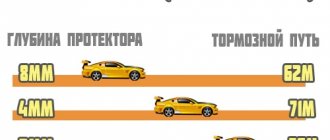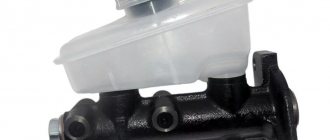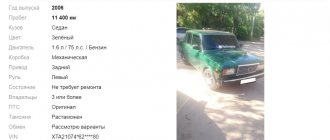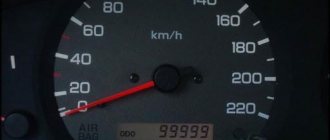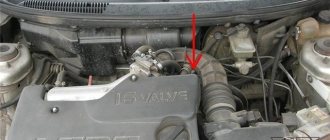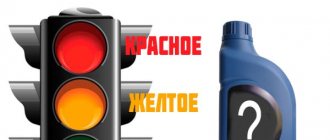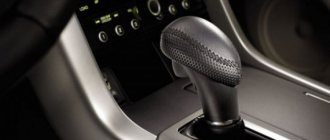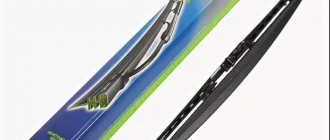Imagine how many fewer accidents there would be if cars could stop instantly. Unfortunately, the elementary laws of physics say that this is impossible.
It is customary for car manufacturers to “boast” about another indicator: acceleration speed up to 100 km/h. Of course, this is also important. But it would be nice to know how many meters the braking distance will stretch. After all, it differs from car to car.
In this article we will talk about what every driver needs to know about braking distances in order to protect themselves on the road. Buckle up and let's go!
What is the braking distance of a car?
The braking distance is the distance that the car will travel after activating the brake system until it comes to a complete stop. This is only a technical parameter by which, in combination with other factors, the safety of the car is determined. This parameter does not include the driver's reaction speed.
The combination of the driver’s reaction to an emergency situation and the distance from the start of braking (the driver pressed the pedal) to the complete stop of the vehicle is called the stopping distance.
The traffic rules indicate critical parameters under which the operation of a vehicle is prohibited. The maximum limits are:
| Transport type: | Braking distance, m. |
| Motorcycle/moped | 7,5 |
| A car | 14,7 |
| Bus/truck weighing up to 12 tons | 18,3 |
| Truck weighing more than 12 tons | 19,5 |
Since the braking distance directly depends on the speed of the vehicle, the critical indicator is the distance covered by the vehicle mentioned above when the speed decreases from 30 km/h. (for motor vehicles) and 40 km/h. (for cars and buses) to zero.
A braking system that responds too slowly will always result in damage to the vehicle and often injury to those in it. For clarity: a car moving at a speed of 35 km/h will collide with an obstacle with a force identical to the impact of a fall from a five-meter height. If the speed of the car in a collision with an obstacle reaches 55 km/h, then the impact force will be identical to that of a fall from the third floor (90 km/h – a fall from the 9th floor, or from a height of 30 meters).
These research results show how important it is for a motorist to monitor the condition of the car’s braking system, as well as tire wear.
How to determine the speed of a car based on the braking distance?
In cases where it was still not possible to brake in time, it is necessary to determine at what speed the vehicle was moving at the moment the braking began. The general formula for calculating the “starting” braking speed looks like this - V = 0.5*t3*j + √2*S*j . In this case, the following factors play a role:
- tЗ is the rise time of the machine deceleration. Measured in seconds;
- j - deceleration of the car when braking. Measured in m/s2. According to GOST on a dry route j=6.8 m ;
- s2 , and on wet - 5 m/s2;
- S is the length of the braking trail.
Let's take conditions in which tЗ = 0.3 seconds, the braking trail is 20 meters, and the track is dry. Then the speed is 0.5*0.3*6.8 + √2*20*6.8 = 1.02 + 19.22 = 20.24 m/s = 72.86 km/h.
Basically, three methods are used to determine the speed at the beginning of braking:
- Determination by braking distance.
- Determination by the law of conservation of momentum.
- Determination by car deformation.
The advantages of the first method are simplicity and speed, a large number of studies, and accurate results. The good thing about the second method is that it can be used when there are no signs of braking, it gives an accurate result and is useful when colliding with stationary cars. The third differs in that it takes into account the energy consumption for the deformation of the machine.
Each method also has its own disadvantages. In the first case, it is impossible to use in the absence of tire marks. In the second there are cumbersome calculations, and in the third there are large volumes of what needs to be taken into account and low accuracy of calculations.
What is the braking distance formula?
There are special formulas that help the driver calculate the braking distance during emergency and normal braking. Of course, they are averages.
So, normal braking involves gently pressing the brake pedal, for example at a traffic light. In this case, we are guided by the formula:
(Speed in km/h: 10) * (speed in km/h: 10) = braking distance in meters
That is, if you are moving at a speed of 50 km/h, the braking distance will be approximately 25 meters. We count like this: 50/10 * 50/10 = 5*5 = 25.
During emergency braking, the resulting value is divided by two more. The formula looks like this.
(Speed, in km/h: 10) * (speed, in km/h: 10) / 2
Let's do the math using a specific example. Let's say you are again moving at a speed of 50 km/h and a situation occurs in which you urgently need to brake. We calculate the braking distance as follows: 50/10 * 50/10 / 2 = 5 * 5/2 = 12.5 meters.
You may say that in an emergency there is no time to count and you need to act. Yes, you are absolutely right. But there is one “but”. Each driver moves around the city at approximately the same speed. Therefore, you can learn the desired value in advance and build on it when needed. This simple life hack could one day save someone's life. So take note of it.
Fact
According to scientists, the driver's reaction to an obstacle is one second. During this time, a car at a speed of 60 kilometers per hour will travel 16 meters. The braking distance itself from this speed will require at least another 16 meters (according to the laws of physics). Therefore, the minimum distance will be 32 meters. But still, calculations are one thing, but practice is another.
In everyday life, under real conditions, it is almost impossible to achieve such effective braking. However, it is possible. Moreover, all calculations are made in such a way that the driver looks carefully at the road and to the sides. And if in an emergency you smoke, talk on the phone or switch the radio, this is out of the question. In such cases, braking distance is critical, and in many cases you simply will not stop, or you will do so after hitting someone.
How to calculate the total stopping time and the final braking distance?
As we noted above, the driver needs time to make a decision to brake. That is, to react. Plus, it takes time to move your foot from the gas pedal to the brake pedal and for the car itself to react to this action.
There is a formula that averages out the driver's reaction path. Here she is:
(Speed in km/h: 10) * 3 = reaction distance in meters
Let's imagine the same situation. You are driving at a speed of 50 km/h and decide to brake smoothly. While you are making a decision, the car will travel 50/10*3 = 15 meters. We calculated the second value (the length of the actual braking distance) to be higher - 25 meters. As a result, 15+25 = 40. This is the distance your car will travel until you come to a complete stop.
Emergency braking
Emergency (emergency) braking is used when there is a danger of a collision or collision.
You should not press the brake too sharply or too hard - in this case, the wheels will lock, the car will lose control, and it will begin to skid along the road.
Symptoms of locked wheels during braking:
- the appearance of wheel vibration;
- reducing vehicle braking;
- the appearance of a scraping or squealing sound from tires;
- The car has skidded and does not respond to steering movements.
IMPORTANT: If possible, it is necessary to perform a warning brake (half a second) for cars following behind, release the brake pedal for a moment and immediately begin emergency braking.
What factors influence braking and stopping distance?
We already wrote above that the length of the braking distance is influenced by many factors. We invite you to consider them in more detail.
Speed
This is the key factor. This means not only the speed of the car, but also the reaction speed of the driver. It is believed that everyone has approximately the same reaction, but this is not entirely true. Driving experience, a person’s health status, medication use, etc. play a role. Also, many reckless drivers ignore the law and are distracted by smartphones while driving, which ultimately can lead to catastrophic consequences.
Remember one more important point. If a car's speed doubles, its braking distance quadruples! The 1:1 ratio doesn't work here.
Road conditions
Undoubtedly, the length of the brake line is influenced by the condition of the road surface. On an icy or wet road it can increase significantly. But these are not all the factors. You should also be wary of fallen leaves, on which tires glide perfectly, cracks in the surface, holes, and so on.
Tires
The quality and condition of the rubber greatly influence the length of the brake line. Often, more expensive tires provide better grip on the road surface. Please note that if the tread depth has worn off beyond the permissible value, then the rubber loses its ability to drain a sufficient amount of water when driving on a wet road. As a result, you may encounter such an unpleasant thing as hydroplaning - when the car loses traction and becomes completely uncontrollable.
To shorten the braking distance, it is recommended to maintain optimal tire pressure. Which one exactly - the automaker will answer this question for you. If the value deviates upward or downward, the braking line will increase.
Depending on the coefficient of adhesion of the tires to the road surface, this indicator will vary. Here is a comparative table of the dependence of the braking distance on the quality of the road surface (a passenger car whose tires have an average coefficient of adhesion):
| 60km/h. | 80 km/h. | 90 km/h. | |
| Dry asphalt, m. | 20,2 | 35,9 | 45,5 |
| Wet asphalt, m. | 35,4 | 62,9 | 79,7 |
| Snowy road, m. | 70,8 | 125,9 | 159,4 |
| Ice, m. | 141,7 | 251,9 | 318,8 |
Of course, these indicators are relative, but they clearly illustrate how important it is to monitor the condition of car tires.
Technical condition of the machine
A car can only go on the road in good condition - this is an axiom that does not require proof. To do this, carry out routine diagnostics of your car, make timely repairs and change the brake fluid.
Remember that worn brake rotors can double the brake line.
Distraction on the road
While the vehicle is moving, the driver has no right to be distracted from driving the vehicle and monitoring the traffic situation. Not only its safety, but the lives and health of passengers, as well as other road users, depend on this.
Here's what happens in a driver's brain when an emergency occurs:
- assessment of the road situation;
- making a decision - to brake or maneuver;
- response to the situation.
Depending on the driver's innate abilities, the average reaction speed ranges from 0.8 to 1.0 seconds. This setting concerns an emergency situation, rather than an almost automatic process when slowing down on a familiar stretch of road.
To many, this time period seems insignificant to pay attention to, but ignoring the danger can lead to fatal consequences. Here is a table of the relationship between the driver’s reaction and the distance traveled by the car:
| Vehicle speed, km/h. | Distance until the brake is pressed (the time remains the same - 1 second), m. |
| 60 | 17 |
| 80 | 22 |
| 100 | 28 |
As you can see, even a seemingly insignificant second of delay can lead to dire consequences. That’s why every motorist should never break the rule: “Don’t be distracted and stick to the speed limit!”
Various factors can distract the driver from driving:
- mobile phone - even just to see who is calling (when talking on the phone, the driver’s reaction is identical to the reaction of a person in a state of mild alcohol intoxication);
- watching a passing car nearby or enjoying beautiful scenery;
- fastening the seat belt;
- eating while driving;
- falling of an unsecured DVR or mobile phone;
- clarification of the relationship between driver and passenger.
In fact, it is impossible to make a complete list of all the factors that can distract a driver from driving. In view of this, everyone should be attentive to the road, and passengers will benefit from the habit of not distracting the driver from driving.
State of alcohol or drug intoxication
The laws of most countries around the world prohibit driving under the influence of drugs or alcohol. This is not because drivers are prohibited from enjoying life to the fullest. The braking distance of the car depends on this condition.
When a person is under the influence of drugs or alcohol, his reaction is reduced (this depends on the degree of intoxication, but the reaction will be slow in any case). Even if the car is equipped with the most advanced systems and braking assistants, pressing the brake pedal too late in an emergency situation will lead to an accident. In addition to braking, a drunk driver reacts more slowly to the need to perform a maneuver.
How to brake on a motorcycle?
Braking correctly on a motorcycle is quite a difficult task. You can brake with the rear wheel, the front wheel, or both, skid or engine. If you brake incorrectly at high speeds, you can lose your balance. In order to calculate the braking distance of a motorcycle at 60 km/h, we also substitute the data into the formula. Taking into account the different braking coefficient and friction coefficient.
Motorcycle braking distance
Dry asphalt: 23 - 33 meters
- Wet asphalt: 35 - 46 meters
- Mud and snow: 70 - 95 meters
- Ice: 95 - 128 meters
The second indicator is the braking distance when the motorcycle is skidding.
Any vehicle owner should know and be able to calculate the braking distance, and it is better to do this visually.
It should be remembered that if a traffic accident occurs, by the length of the skid that will remain on the road surface, you can determine the speed of the vehicle before colliding with an obstacle, which can indicate that the driver has exceeded the permissible speed and make him the culprit of the incident.
Factors influencing braking distance and driver reaction time:
| Factors influencing driver reaction time | - Weather — Visibility conditions (poor visibility, night, or bright sun) — Driver’s condition (fatigue, intoxication) — Individual driver experience |
| Factors influencing the braking distance | — Serviceability of the brake system (obviously) — Tire condition (tread height, air pressure) — Manufacturer, brand and type of tires (winter, summer, Velcro) — Vehicle weights (car, truck, empty, loaded) — Availability of ABS and other modern auxiliary systems — Movement speed (one of the main factors) |
Emergency braking
Emergency (emergency) braking is used when there is a danger of a collision or collision.
You should not press the brake too sharply or too hard - in this case, the wheels will lock, the car will lose control, and it will begin to skid along the road.
Symptoms of locked wheels during braking:
- the appearance of wheel vibration;
- reducing vehicle braking;
- the appearance of a scraping or squealing sound from tires;
- The car has skidded and does not respond to steering movements.
IMPORTANT: If possible, it is necessary to perform a warning brake (half a second) for cars following behind, release the brake pedal for a moment and immediately begin emergency braking.
Types of emergency braking
1. Intermittent braking - press the brake (without allowing the wheels to lock) and release completely. Repeat this until the machine stops completely.
When you release the brake pedal, you need to align the direction of movement to avoid skidding.
Intermittent braking is also used when driving on slippery or uneven roads, braking before potholes or icy areas.
2. Step braking - press the brake until one of the wheels locks, then immediately release the pressure on the pedal. Repeat this until the machine stops moving completely.
When you release pressure on the brake pedal, you need to align the direction of movement with the steering wheel to avoid skidding.
3. Engine braking on cars with a manual transmission - press the clutch, change to a lower gear, use the clutch again, etc., alternately lowering to the lowest.
In special cases, you can lower the gear not in order, but several at once.
4. Braking with ABS: if a passenger car has an automatic transmission, during emergency braking it is necessary to press the brake as hard as possible until it comes to a complete stop, and on cars with a manual transmission, simultaneously press firmly on the brake and clutch pedals.
When the ABS system is activated, the brake pedal will twitch and a crunching sound will appear. This is normal, you should continue to press the pedal as hard as you can until the car stops.
PROHIBITED: During emergency braking, use the parking brake - this will lead to the car turning around and uncontrolled skidding due to the complete blocking of the car's wheels.
Car braking distance table
The table shows the approximate average braking distances on a horizontal section of the road for passenger cars, for different road surfaces and their conditions (dry, wet, snow, ice), at various speeds from 10 to 120 km/h.
| Type of road surface | Coating condition | Vehicle speed, km/h | |||||
| 10 | 20 | 30 | 40 | 50 | 60 | ||
| Vehicle braking distance, m | |||||||
| Asphalt concrete | Dry | 0.57—0.49 | 2.25—1.95 | 5—4.4 | 9—7.85 | 14.1—12.3 | 20.3—17.8 |
| Wet | 1.3—0.99 | 5.25—3.95 | 11.8—8.9 | 21—15.7 | 33—24.5 | 47.4—35.5 | |
| Crushed stone highway | Dry | 0.66—0.57 | 2.7—2.25 | 5.9—5 | 10.4—9 | 16.5—14 | 23.6—20.3 |
| Wet | 1.3—0.99 | 5.25—3.95 | 11.8—8.9 | 21—15.7 | 33—24.5 | 47.4—35.5 | |
| Stone ends | Dry | 0,99—0.66 | 3.15—2.7 | 7.1—5.9 | 12.5—10.4 | 19.7—16.5 | 28.4—23.6 |
| Wet | 1.3—1.1 | 5.25—4.5 | 11.8—10 | 21—18 | 33—28 | 47.4—40.5 | |
| Dirt road, clay | Dry | 0.99—0.66 | 3.15—2.7 | 7.1—5.9 | 12.5—10.7 | 19.7—16.5 | 28.4—23.6 |
| Wet | 1,97—1.3 | 7.85—3.95 | 17.6—8.8 | 31.4—15.7 | 49.4—24.5 | 70.6—35.5 | |
| Sand | Dry | 1.3—0.99 | 3.95—3.15 | 8.9—7.1 | 15.7—12.5 | 24.5—19.7 | 35.5—28.4 |
| Wet | 0.99—0,66 | 3.15—2.17 | 7,1—5.9 | 12.5—10.4 | 19.7—16.5 | 28.4—23.6 | |
| Compacted slag | Dry | 0.99—0.66 | 3.15—2.7 | 7.1—5.9 | 12.5—10.4 | 19.7—16.5 | 28.4—23.6 |
| Compacted snow | — | 1.97—1.3 | 7.85—5.25 | 17.6—11.8 | 31.4—21 | 49.4—33 | 70.6—47.4 |
| Icy road | — | 4.9—3.9 | 19.7—15.7 | 44—35.4 | 79—63 | 123—98 | 177—142 |
| Type of road surface | Coating condition | Vehicle speed, km/h | |||||
| 70 | 80 | 90 | 100 | 110 | 120 | ||
| Vehicle braking distance, m | |||||||
| Asphalt concrete | Dry | 25.6—24.2 | 37—31.5 | 45.7—40 | 56.3—49.3 | 63.2—59,9 | 81.4—71.4 |
| Wet | 64.5—48.5 | 83.8—63 | 106—80 | 131.5—97.5 | 158.5—118.5 | 188.5—141.5 | |
| Crushed stone highway | Dry | 32.2—27.6 | 42—36 | 53.3—45.5 | 65.6—56.4 | 79.5—67 | 94.5—81 |
| Wet | 64.5—43.5 | 83.8—63 | 106—80 | 131.5—97.5 | 158.5—118.5 | 188.5—141.5 | |
| Stone ends | Dry | 38.6—32.2 | 50.3—42 | 64—53.3 | 78.7—65.6 | 95—79.5 | 113—94.5 |
| Wet | 64.4—55.2 | 83.8—71.7 | 106—91.3 | 131.5—113 | 158.5—136 | 188.5—161,5 | |
| Dirt road, clay | Dry | 38.6—32.2 | 50.3—42 | 64—53.3 | 78.7—65.6 | 95—79.5 | 113—94.5 |
| Wet | 97—48.5 | 125.5—63 | 159—80 | 197—97.5 | 237—118.5 | 284—141.5 | |
| Sand | Dry | 48.5—38.6 | 63—50.3 | 80—64 | 97.5—78.7 | 111.5—95 | 141.5—113 |
| Wet | 38.6—32.2 | 50.3—42 | 64—53.3 | 78.7—65 6 | 95—79.5 | 113—94.5 | |
| Compacted slag | Dry | 38.6—32.2 | 50.3—42 | 64—53.3 | 73.7—65.6 | 95—79.5 | 113—94.5 |
| Compacted snow | — | 97—64,5 | 125.5—83.8 | 159—106 | 197—78.7 | 237—158.5 | 284—183.5 |
| Icy road | — | 240—193 | 315—252 | 398—316 | 494—394 | 593—475 | 706—575 |
The graph below shows the braking distance of a car on winter tires of different manufacturers and brands, on wet and dry asphalt.
What is the braking distance at speeds of 50, 80 and 110 km/h.
As you can see, due to the many variables, it is impossible to create a clear table describing the exact stopping distance of an individual vehicle. This is influenced by both the technical condition of the car and the quality of the road surface.
Average braking distance data for a passenger car with a working system, high-quality tires and normal driver reaction:
| Speed, km/h. | Approximate braking distance, m. |
| 50 | 28 (or six car bodies) |
| 80 | 53 (or 13 car bodies) |
| 110 | 96 (or 24 cases) |
The following conditional situation shows why it is important to stick to the speed limit and not rely on “ideal” brakes. To stop in front of a pedestrian crossing from a speed of 50 km/h to zero, a car will need a distance of almost 30 meters. If the driver violates the speed limit and moves at a speed of 80 km/h, then when reacting at a distance of 30 meters before the crossing, the car will hit a pedestrian. In this case, the speed of the car will be about 60 km/h.
As you can see, you should never rely on the reliability of your car, but it is correct to follow the recommendations, because they are taken from real situations.
Distance
- Three car lengths . Anyone traveling in urban areas must maintain a distance of at least 15 meters, or three car lengths.
- Half speedometer : for a safe distance outside of populated areas, pay attention to the speed of the car. In order to calculate a safe distance, divide by 2 the current speed shown by the speedometer. As a result, you will get the distance to other cars in meters. Example: At a speed of 70 km/h, you must keep at least 35 meters from the vehicle in front. Moreover, this applies to dry asphalt in the summer.
- Double distance : In case of poor visibility or bad road conditions, you should double the safe distance.
What determines the average braking distance of any car?
To summarize, we see that the braking distance of any car depends on a combination of such factors:
- vehicle speed;
- machine weight;
- serviceability of brake mechanisms;
- tire adhesion coefficient;
- quality of the road surface.
The driver's reaction also influences the car's stopping distance.
Considering that in an emergency the driver's brain needs to process a lot of information, sticking to the speed limit is the very first commandment, the importance of which will never stop being talked about.
Road conditions.
You also need to know that on a wet or icy road, the braking distance certainly increases. The fact is that on a slippery surface, the car’s grip on the road is greatly reduced, which leads to an increase in braking distance when braking.
For example, in icy conditions the braking distance of any car can increase tenfold!
When and how measurements are taken
Braking distance calculations will be needed when a vehicle is being examined after a serious accident (forensic examination), during technical testing of the car, and also after upgrading the braking system.
There are various online calculators with which the driver can independently check these parameters of his car. An example of such a calculator can be found at this link . You can use this calculator right on the road. The main thing is to have Internet access. A little later we will look at what formulas can be used to calculate this parameter.
Tires.
Car tires are also an important factor that affects the final braking distance of a car. Firstly, this length of braking distance depends on the degree of wear of the rubber tread, as well as on the brand of tires. Naturally, the more expensive the brand and model of tires, the more and more reliable it provides the car with grip on the road. In addition, on a wet road, braking distance also depends on the condition of the tire tread and its specification itself. If the rubber is sufficiently worn, the tire tread depth will be shallow, which will lead to insufficient drainage of water from the tires. As a result, road grip will decrease, and this in turn will affect the braking distance of the car when braking.
First big review of the new 2022 Mercedes E-Class station wagon in Russia
Also, don’t forget about tire pressure, which must be maintained in accordance with the car manufacturer’s recommendations. Remember, friends, that low tire pressure (or too high) will lead to an increase in braking distance on any road. Therefore, it is very important not only to monitor the condition of the tires, but also to replace them with new ones in a timely manner, periodically checking the pressure in them.
How to increase the intensity of deceleration
First of all, the effectiveness of deceleration depends on the driver’s attentiveness. Even the best braking system and a full range of electronic assistants are not capable of changing physical laws. Therefore, in no case should you be distracted from driving by making phone calls (even if a hand-free system is used, the reaction of some drivers may slow down significantly), texting or looking at beautiful landscapes.
An equally important factor is the driver’s ability to anticipate an emergency situation. For example, when approaching an intersection, even if there is a secondary road adjacent to the main road and there is a “Give Way” sign on it, the driver needs to be more concentrated. The reason is that there are motorists who believe that the size of their car gives an advantage on the road, regardless of the signs. In such situations, it is better to be prepared for emergency braking than to later find out who should yield to whom.
Turns and maneuvers on the road must be performed with equal concentration, especially taking into account blind spots. In any case, the driver’s concentration affects the reaction time and, as a result, the deceleration of the car. But no less important is the technical condition of the vehicle, as well as the presence of additional systems that increase braking efficiency.
Also, if the driver chooses a safe speed, this can significantly reduce the braking distance of the car. This concerns the actions of the driver.
Additionally, it is necessary to take into account the load of the machine, as well as the capabilities of the braking system. That is, the technical part of the vehicle. Many modern car models are equipped with various amplifiers and additional systems that significantly reduce the reaction path and the time it takes for the car to come to a complete stop. Such mechanisms include brake boosters, the ABS system, as well as electronic assistants that prevent frontal collisions. The installation of improved brake pads and discs also significantly reduces the braking distance.
But no matter how “independent” the car’s electronics or reliable brake system actuators were, no one canceled the driver’s attentiveness. In addition to the above, it is extremely important to monitor the serviceability of the mechanisms and carry out scheduled maintenance in a timely manner.
State of alcohol or drug intoxication.
Driving while under the influence of alcohol or drugs actually also affects the final braking distance of the car. The fact is that alcohol or drugs reduce and slow down the driver’s reaction speed several times. Accordingly, all movements behind the wheel will be slower. Although this may not be noticeable from the outside, in fact, the reaction of a drunk driver when braking (and not only) will indeed be reduced. And on the road, as you and I know, everything is usually decided by a few milliseconds. This is why a drunk driver driving is very dangerous. Indeed, in the event of emergency braking, a driver in a state of alcoholic or drug intoxication will, if necessary, press the brake pedal with a delayed reaction. As a result, the car will travel an additional considerable distance before it starts to stop, which will ultimately add extra meters to the braking distance.
Stopping and braking distance of a car: what is the difference
Braking distance refers to the distance a car will cover from the moment the driver presses the brake pedal. The beginning of this path is the moment the brake system is activated, and the end is the complete stop of the vehicle.
This value always depends on the speed of the vehicle. Moreover, it is always quadratic. This means that the braking distance is always proportional to the increase in vehicle speed. If the vehicle speed is twice the speed limit, the car will come to a complete stop at a distance four times the average.
This value is also affected by the weight of the vehicle, the condition of the braking system, the quality of the road surface, as well as tread wear on the wheels.
But the processes that affect the complete stop of the car include a much longer period of time than the time it takes for the brake system to respond. Another equally important concept that affects the deceleration of a car is the driver’s reaction time. This is the period of time during which the driver reacts to a detected obstacle. For the average motorist, it takes about one second between detecting an obstacle and pressing the brake pedal. For some, this process takes only 0.5 seconds, while for others it takes much longer, and they activate the brake system only after two seconds.
The reaction path is always directly proportional to the speed of the car. The reaction time of a particular person may not change, but depending on the speed, during this time the car will cover its distance. These two quantities: braking distance and reaction path together form the stopping distance of the car.
Safe distance between cars
According to clause 13.1 of the Traffic Rules, the driver must keep a sufficient distance from the vehicle in front that will allow him to brake in time.
Failure to maintain distance is one of the main causes of transport accidents.
When a vehicle in front comes to a sudden stop, the driver of a car closely following him does not have time to brake. The result is a collision between two and sometimes more vehicles.
To determine the safe distance between cars while driving, it is recommended to take an integer speed value. For example, the speed of a car is 60 km/h. This means that the distance between him and the vehicle in front should be 60 meters.
How to calculate the total stopping time and the final stopping distance?
It is impossible to carry out accurate calculations on an abstract car. Often the braking distance is calculated based on what this value was for a particular car at a certain speed. As we have already said, the increase in braking distance is quadratic to the increase in vehicle speed.
But there are also statistical averages. It is accepted that an average-sized passenger car at a speed of 10 km/h has a braking distance of 0.4 m. If we take this ratio as a basis, then we can calculate the braking distance for vehicles moving at a speed of 20 km/h (the value is 1.6 m) or 50 km/h (the value is 10 meters) and so on.
To more accurately calculate the braking distance, you need to use additional information. For example, if we take into account the degree of tire resistance (the friction coefficient for dry asphalt is 0.8, and for an icy road - 0.1). This parameter is substituted into the following formula. Braking distance = square of the speed (in kilometers/hour) divided by the friction coefficient multiplied by 250. If the car is moving at a speed of 50 km/h, then according to this formula the braking distance is already 12.5 meters.
To obtain a specific figure for the driver's reaction path, there is another formula. The calculations are as follows. Reaction path = car speed divided by 10, then multiplied by 3. If we substitute the same car moving at a speed of 50 km/h into this formula, then the reaction path will be 15 meters.
The car will come to a complete stop (the same speed of 50 kilometers per hour) in 12.5+15=27.5 meters. But these are not the most accurate calculations.
Thus, the time of complete stop of the vehicle is calculated by the formula:
P (full stop) = (multiplier of the braking efficiency coefficient and initial braking speed divided by the multiplier of free fall acceleration and the coefficient of longitudinal adhesion of tires to asphalt) + driver reaction time + response period of the brake system drive + multiplier of the braking force rise time by 0.5.
So, as you can see, the determination of a complete stop of a car is influenced by many factors, which can be completely different depending on the situation on the road. For this reason, once again: the driver must always control what is happening on the road.
Braking in different conditions
The length of the braking distance is inversely proportional to the coefficient of adhesion to the road. Simply put, the worse the road holds, the longer the car slows down. Let's look at the changes in the coefficient (Fs) in more detail:
- with dry asphalt - 0.7;
- on wet asphalt - 0.4;
- if the snow is rolled - 0.2;
- icy road - 0.1.
These numbers allow us to see how stopping distances will change depending on conditions. As already mentioned, at a speed of 60 km/h on a dry road the car will brake in 20.25 meters, and on ice - 141.7. On a wet track the braking distance will be 35.4 meters, and on a snowy track - 70.8.
How to increase the intensity of deceleration
To minimize braking distance in different circumstances, the driver can use one of two methods. A combination of these methods would be best:
- Driver discretion. This method assumes the driver’s ability to anticipate dangerous situations and choose a safe speed limit and the correct distance. For example, on a flat and dry road, the Moskvich can be accelerated, but if the road is slippery and winding with a large flow of cars, then in this case it would be better to reduce the speed. Such a car will brake less effectively than a modern foreign car. It is also worth paying attention to what braking technique the driver uses. For example, in a car that is not equipped with any assistance system, such as ABS, pressing the brake hard all the way down often results in loss of traction. To prevent the car from skidding on an unstable road, it is necessary to use engine braking in a low gear and intermittently press the brake pedal.
- Car modification. If a car owner equips his vehicle with more efficient elements on which braking depends, then he will be able to increase the intensity of the deceleration of his car. For example, you can improve braking efficiency by installing better brake pads and discs, as well as good tires. If the car allows you to install additional mechanisms or even auxiliary systems (anti-lock braking, braking assistant), this will also reduce the braking distance.
Types of braking
It is also worth considering that the method of braking plays a big role:
- A sharp press can send the car into an uncontrolled skid.
- Gradually pressing the pedal will work if there is good visibility and time to spare, but it cannot be used in an emergency situation.
- Intermittent braking with several presses of the pedal to the stop will allow you to quickly stop the car, but is also fraught with loss of control.
- Pressing in steps will allow you to lock the wheels without losing contact with the pedal.
In winter conditions, ABS will increase the braking distance by 15-30 meters when driving on snow or ice. At the same time, the system will leave the driver control of the car, which can be critically important when driving on ice.
Friction table at different speeds
Remember, the weak points of ABS are muddy soil and clay. The braking distance may also be longer with them than with fully “manual” braking. But control over the car will also remain.
Technical condition of the vehicle.
Of course, any car should only go on the road in acceptable, good technical condition. To do this, it is necessary to periodically carry out scheduled diagnostics of all important vehicle systems, as well as at the same time carry out timely maintenance and necessary repairs.
Please remember that the technical condition of the car directly affects its braking distance in the event of emergency braking.
For example, bad brake pads, brake rotors or drums, or old brake fluid can cause your vehicle's stopping distance to double.
Remember also that in addition to the technical condition of the vehicle, you must keep the car clean. For example, a dirty windshield may cause you to miss (or not notice) an obstacle on the road and press the brake pedal too late. As a result, the braking distance of the car can increase significantly, which naturally can lead to an accident.
Dirty headlights may also not illuminate the road enough at night. In this case, you and your friends run the risk of simply not noticing the danger on the road in time and reacting to it too late, thereby increasing the braking distance of your car.
Distraction on the road
When we drive, we must be as attentive and focused on the road as possible. But unfortunately, we are often distracted by many things on the road, as a result of which our reaction while driving is reduced, which often leads to an accident.
For example, the driver’s main enemy is a mobile phone, smartphone and tablet. According to current legislation in our country there is a ban on the use of mobile devices while driving a car. But unfortunately, few people in Russia comply with this law.
But this ban was actually made for a reason. The fact is that, according to research, talking on a cell phone while driving a car distracts the driver and reduces attention. Including a mobile phone, the driver’s reaction is greatly reduced. For example, it has been officially established that a driver talking on a mobile phone while driving begins to behave like a driver driving a car in a state of mild alcohol intoxication. Why is this happening? The thing is that our brain is not limitless and cannot process too much information at the same time. As a result, when we talk on the phone while driving, our reaction decreases several times, which often becomes the cause of an accident. For example, due to the fact that the driver started to brake at the wrong time, which ultimately led to an increase in braking distance.
All of the above factors directly affect the final stopping distance when the car is braking. After all, all these things lead to an increase in the time to come to a complete stop, which ultimately leads to a longer braking distance.
Of course, in our article we did not indicate all the reasons why the braking distance may increase. In fact, there are a huge number of them. But we have indicated the most important factors that directly affect the braking distance of any vehicle.
84% of Russian drivers do not know how to calculate braking distance depending on speed, and only 12% of car owners can correctly assess the situation. Such conclusions can be drawn from the results of a survey conducted on the traffic police website.

